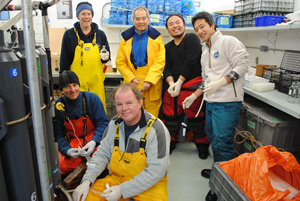Please note: You are viewing
the unstyled version of this website. Either your browser does not support CSS
(cascading style sheets) or it has been disabled. Skip
navigation.
Dr. Mary-Louise TimmermansAugust 14, 2011On this year’s expedition, we collected water samples from all depths in the Canada Basin water column to analyze dissolved oxygen, dissolved inorganic carbon (DIC), alkalinity, isotopes of oxygen and argon, chlorophyll, salinity, ammonium, nutrients (nitrate, phosphate and silicate), colored dissolved organic matter (CDOM), phytoplankton, microzooplankton, barium, bacteria and pH. In addition to water samples from the Niskin bottles on the Rosette, a total of 86 net tows were made to collect zooplankton in the upper 500 m of the water column. Some samples are being stored for analysis on shore (oxygen isotopes, barium, bacteria and CDOM), while others were analyzed on board. This is the first year that DIC has been analyzed on board (by Martin Davelaar and Glenn Cooper from IOS), removing the possibility that samples will be compromised in transit, which can happen if they freeze, for example. More attention has been paid to ocean acidification and inorganic carbon than in previous years, with an increased quantity of DIC and alkalinity samples this year as a component of the GO-SHIP (Global Ocean Ship-Based Hydrographic Investigations Program) focus on ocean acidification. The comprehensive bio-geochemical sampling in the Canada Basin has been ongoing since 2003, with opportunity for new analyses each year. This year, for example, the group have been sampling for dissolved oxygen isotopes and argon as part of a program to examine net community biological production in the Arctic. Bill Williams and Sarah Zimmermann (IOS) coordinate quality control, synthesis and analyses of these data and have been busy these past few days bringing together final data reports from the other scientists on board. The samples collected and analyzed this year will expand our knowledge of the physical environment and biota of the Arctic Ocean, and the complex bio-physical interactions in a changing climate system. Last updated: October 7, 2019 | |||||||||||||||||
Copyright ©2007 Woods Hole Oceanographic Institution, All Rights Reserved, Privacy Policy. | |||||||||||||||||



